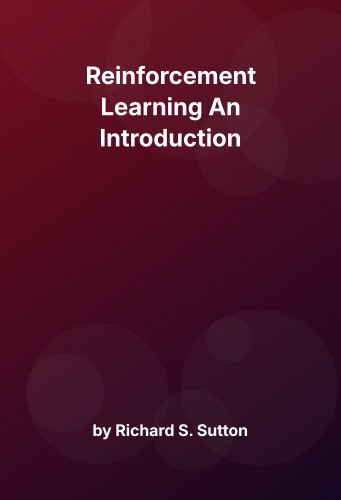Reinforcement Learning: Transformative Insights for the Modern Professional
Reinforcement Learning (RL) is not just a cornerstone of artificial intelligence but a framework that offers profound insights into decision-making, strategy, and adaptation. Richard S. Sutton’s “Reinforcement Learning An Introduction” provides a comprehensive exploration of these concepts, offering strategic guidance that transcends traditional AI applications and extends into realms of business strategy and leadership.
The Essence of Reinforcement Learning: A Strategic Framework
At its core, reinforcement learning is about learning from interaction. This principle is not only fundamental to AI but also to business strategy. In a dynamic market, organizations must continuously learn from their interactions with the environment, much like an RL agent learns from its actions and rewards. This iterative process of trial and error, combined with strategic planning, is crucial for businesses aiming to stay ahead in a competitive landscape.
Learning from Feedback Loops
A key theme in RL is the feedback loop, where actions are taken, outcomes are observed, and strategies are adjusted accordingly. This mirrors the agile methodologies prevalent in modern business practices, where iterative cycles and continuous feedback are essential. By adopting an RL mindset, professionals can enhance their ability to adapt to change, optimize processes, and innovate.
Decision-Making Under Uncertainty: Navigating Complex Environments
Reinforcement learning excels in environments where uncertainty is a given. This is akin to the challenges faced by leaders in volatile markets. Sutton’s work emphasizes the importance of exploration and exploitation—balancing the need to explore new opportunities with the need to exploit known resources. This dual strategy is vital for businesses seeking sustainable growth.
The Exploration-Exploitation Dilemma
In business, the exploration-exploitation dilemma manifests in decisions about resource allocation, market expansion, and innovation. Companies must decide when to invest in new ventures and when to capitalize on existing strengths. By applying RL principles, leaders can develop strategies that optimize this balance, ensuring long-term success.
Value-Based Decision-Making: Leveraging Data for Strategic Advantage
One of RL’s strengths is its ability to quantify the value of actions, allowing for data-driven decision-making. This is increasingly relevant in today’s data-centric world, where businesses must leverage analytics to inform strategy. Sutton’s exploration of value functions and policy optimization provides a framework for integrating data insights into business decisions.
Integrating Analytics and Strategy
Organizations can harness RL techniques to enhance their data analytics capabilities, transforming raw data into actionable insights. By understanding the value of different actions, businesses can prioritize initiatives that offer the highest potential return, aligning with strategic objectives and driving competitive advantage.
Adaptive Learning and Continuous Improvement: Building a Resilient Organization
The adaptive nature of RL aligns with the principles of continuous improvement and organizational resilience. In a rapidly changing environment, businesses must be agile, learning from past experiences to refine strategies and improve performance.
Building a Learning Organization
Sutton’s insights into adaptive learning can inform the development of a learning organization. By fostering a culture of experimentation and feedback, companies can enhance their ability to respond to change, innovate, and improve processes. This approach not only boosts efficiency but also empowers employees, driving engagement and performance.
From Theory to Practice: Implementing RL Concepts in Business
While RL is rooted in complex mathematical models, its principles can be applied in practical business contexts. By translating RL concepts into actionable strategies, professionals can enhance decision-making, optimize operations, and drive transformation.
Practical Applications and Case Studies
Sutton’s work provides a foundation for applying RL in various industries, from finance to healthcare. By examining case studies and real-world applications, professionals can gain insights into how RL can be leveraged to solve complex problems, improve customer experiences, and achieve strategic goals.
Final Reflection: Embracing the Future with Reinforcement Learning
Reinforcement learning offers a powerful framework for navigating the complexities of the modern business environment. By embracing its principles, professionals can enhance their strategic capabilities, drive innovation, and achieve lasting success. Sutton’s insights provide a roadmap for leveraging RL to transform organizations, making it an indispensable resource for leaders in the digital age.
Through the lens of RL, we find parallels with other influential works such as “Thinking, Fast and Slow” by Daniel Kahneman, which delves into the dual systems of thought—akin to the exploration-exploitation balance in RL. Similarly, “The Lean Startup” by Eric Ries emphasizes a build-measure-learn feedback loop, resonating with the iterative nature of RL.
In leadership and design, RL principles can be adapted to foster environments that encourage exploration while maintaining a focus on current capabilities. This balance is crucial not only for business success but also for personal development and innovation across various fields. As we integrate these insights, the potential for cross-domain synthesis grows, providing a holistic approach to solving complex challenges.
In conclusion, Sutton’s work invites us to rethink our approach to strategy and decision-making, urging professionals across sectors to adopt a mindset that is both analytical and adaptive. Whether in AI, business, or beyond, reinforcement learning offers transformative insights that are vital for thriving in an ever-evolving world.

